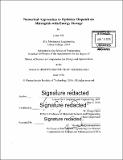| dc.contributor.advisor | W. Craig Carter. | en_US |
| dc.contributor.author | Xie, Lutao | en_US |
| dc.contributor.other | Massachusetts Institute of Technology. Computation for Design and Optimization Program. | en_US |
| dc.date.accessioned | 2016-09-30T19:36:01Z | |
| dc.date.available | 2016-09-30T19:36:01Z | |
| dc.date.copyright | 2016 | en_US |
| dc.date.issued | 2016 | en_US |
| dc.identifier.uri | http://hdl.handle.net/1721.1/104567 | |
| dc.description | Thesis: S.M., Massachusetts Institute of Technology, Computation for Design and Optimization Program, 2016. | en_US |
| dc.description | Cataloged from PDF version of thesis. | en_US |
| dc.description | Includes bibliographical references (pages 49-50). | en_US |
| dc.description.abstract | Microgrids and distributed generation are predicted to become extremely dominant in developing nations, and will be largely beneficial to both electricity suppliers and consumers. With the penetration of renewable energy into the electricity supply, to maintain a balance between power supply and demand is becoming more difficult. Nevertheless, it is quite feasible that large electrical storage systems such as batteries can efficiently mitigate problems caused by the intermittency of renewables, and thus enable stable adoption of such power sources. In order to understand how the energy capacity and power characteristics of batteries should be specified to optimize economic or socioeconomic benefits, an optimizing strategy for battery usage in microgrids energy scheduling was constructed. This strategy is based on the past power consumption, predictions of day-ahead power consumption, and historical trends of seasonal and daily trends, which gives a nonlinear, discontinuous and high dimensional objective function. Optimizing such an objective function is found to be very computational intensive and complex. In this paper, the nature of this large-scale optimization problem is studied. For real time dispatch, four optimization methods including active-set, interior-point method, sequential quadratic programming (SQP) and trust-region-reflective are discussed and compared to find the relatively fast and robust optimization algorithm. The computation was implemented by using the MATLAB nonlinear programming solver 'fmincon'. Three main objectives are carried out to improve the efficiency of solving this optimization problem: (1) determination of the mathematical& physical definitions of tolerances and discussion on convergence criteria with the corresponding tolerances; (2) Study and comparison on influences of the initial condition and the behavior of the objective function (highly related to peak demand charge); and (3) suggestions on modification of the model to achieve reduction of the computation time whilst maintain acceptable accuracy. | en_US |
| dc.description.statementofresponsibility | by Lutao Xie. | en_US |
| dc.format.extent | 50 pages | en_US |
| dc.language.iso | eng | en_US |
| dc.publisher | Massachusetts Institute of Technology | en_US |
| dc.rights | M.I.T. theses are protected by copyright. They may be viewed from this source for any purpose, but reproduction or distribution in any format is prohibited without written permission. See provided URL for inquiries about permission. | en_US |
| dc.rights.uri | http://dspace.mit.edu/handle/1721.1/7582 | en_US |
| dc.subject | Computation for Design and Optimization Program. | en_US |
| dc.title | Numerical approaches to optimize dispatch on microgrids with energy storage | en_US |
| dc.type | Thesis | en_US |
| dc.description.degree | S.M. | en_US |
| dc.contributor.department | Massachusetts Institute of Technology. Computation for Design and Optimization Program | |
| dc.identifier.oclc | 958660844 | en_US |
